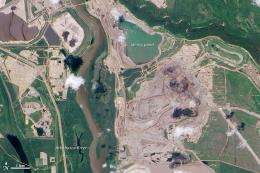March 13, 2012 report
University team says Canadian oil sands mining plans don’t include damage to peatlands

(PhysOrg.com) -- David Schindler and colleagues at the University of Alberta have published a paper in the Proceedings of the National Academy of Sciences in which they detail what they believe is the true impact of oil sands mining in Alberta Canada. In it, they dispute the degree of environmental impact given by mining companies, saying that such reports thus far have neglected to take into account damage to peatlands that will not be restored following mining operations.
Oil sands mining in Canada has become a hot topic of late due to the heavy toll it exerts on the environment. Because the oil in such deposits doesn’t sit in underground pools as has been the case with most previous mining operations, which require little more than digging a well, it must be either surface mined and processed or steam injected to remove it from the sand in which is embedded, a dirty and energy intensive process.
Making matters worse, say Schindler et al, is the fact that 65% of the proposed mining land is made up of peatlands, which are of course by nature, wet. They also say that the peatlands under consideration are currently holding on to 11-47 million metric tons of carbon that will be released into the atmosphere as part of the mining process. And then, because the mining companies plan to return the land to dry forest instead of the original peatlands, the area will lose the ability to sequester carbon in the future; this they say will add up to about 5,700-7,200 mt of carbon each year, which they say should be looked at as a net gain of carbon emissions each year.
Then of course, once the oil is extracted, it will be refined and sold, adding the group says, 22 billion more metric tons of carbon to the atmosphere. And even that is not the end of the story. By adding more carbon to the atmosphere, global temperatures will rise, thawing some of the permafrost in Canada (and elsewhere) adding as much as 30 to 60 billion mt more carbon to the atmosphere over the next thirty years. They also point out that restoring the land to dry forest will increase the number of forest fires each year, which will release even more carbon.
Schindler and his team conclude by suggesting that the public should be made fully aware of the true consequences of mining oil sands before public officials make decisions regarding whether to go ahead with such projects or not.
More information: Oil sands mining and reclamation cause massive loss of peatland and stored carbon, PNAS, Published online before print March 12, 2012, doi: 10.1073/pnas.1117693108
Abstract
We quantified the wholesale transformation of the boreal landscape by open-pit oil sands mining in Alberta, Canada to evaluate its effect on carbon storage and sequestration. Contrary to claims made in the media, peatland destroyed by open-pit mining will not be restored. Current plans dictate its replacement with upland forest and tailings storage lakes, amounting to the destruction of over 29,500 ha of peatland habitat. Landscape changes caused by currently approved mines will release between 11.4 and 47.3 million metric tons of stored carbon and will reduce carbon sequestration potential by 5,734–7,241 metric tons C/y. These losses have not previously been quantified, and should be included with the already high estimates of carbon emissions from oil sands mining and bitumen upgrading. A fair evaluation of the costs and benefits of oil sands mining requires a rigorous assessment of impacts on natural capital and ecosystem services.
Journal information: Proceedings of the National Academy of Sciences
© 2011 PhysOrg.com















